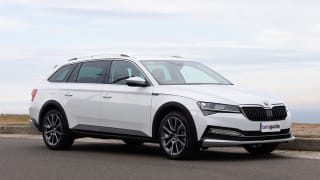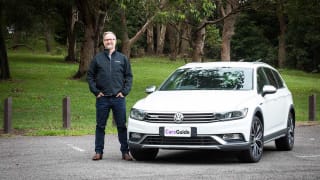The fact that the Subaru Outback range starts at under $40,000 is genuinely staggering, as this really is a lot of car for the money.
Prices have, however, risen compared to the old model, which Subaru says reflects additional equipment and safety tech.
The range starts with the entry-level Outback AWD at $39,990 but we’ve got the mid-range AWD Sport at $44,490 (the top-spec AWD Touring is $47,490).
Our Outback comes with model-specific dark 18-inch alloy wheels, a full size alloy spare, LED headlights, LED foglights, push-button start, keyless entry, electric park brake, rain-sensing wipers, heated and power-folding side mirrors, fabric seat trim, leather steering wheel, paddle-shifters, electric adjustment for the front seats, rear seats with manual recline, and a 60:40 split-fold rear seat with boot release levers.
There’s also a genuinely impressive 11.6-inch touchscreen in portrait layout - reminiscent of Tesla’s although not quite as outstanding - which incorporates Apple CarPlay and Android Auto smartphone mirroring.

There are six speakers standard, as well as four USB ports (2x front, 2x rear).
Other aesthetic touches for our Sport spec include black exterior trim, fixed roof rails, a power tailgate, water repellent interior trim with lurid green stitching, heated front and outboard rear seats, sports pedals, light-sensing headlights (auto on/off) and sat nav as part of that big media screen.
There’s also a front view and side view monitor for parking/low speed driving.
What you miss out on by not going to the top-spec Touring are the electric sunroof, Nappa leather interior trim, a heated steering wheel, auto dipping passenger side door mirror, memory settings for driver’s seat, satin finish door mirrors, silver highlight roof rails (with stowable crossbars), and gloss-finish wheel, and a better stereo.
Unless you really want leather, I think the Sport is the sweet spot here, and hugely well specified at the price.

The Sport gets all the impressive safety tech, too, including a driver monitoring system that warns you to keep your eyes on the road (it really works, too, not the I looked at my phone and got beeped at) and monitor for signs of drowsiness.
All models come with a reversing camera, Subaru’s EyeSight forward facing camera system that incorporates AEB, lane keeping, adaptive cruise control and more.
Not having a wireless phone charger didn’t bother me overly, but considering how many Hyundais it’s now in as standard, it probably should be in the Outback.
Colour wise, I was wearing a no-cost optional layer of something called Autumn Green Metallic. I liked it, a lot of people did not.






















